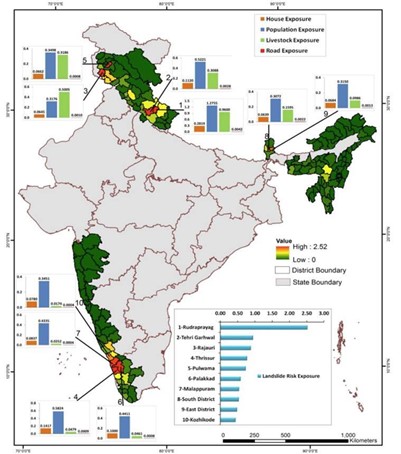-
03 Feb 2024
GS Paper 1
Geography
Day 66: Identify areas prone to landslide vulnerability in India and outline the potential consequences. Suggest measures. (250 words)
- Start the answer with a discussion that sets a context for the question.
- Discuss the areas prone to landslide vulnerability in India.
- Outline the potential consequences of Landslides.
- Conclude suitably.
Introduction
Landslides refer to the downward movement of rock, soil, and debris on a slope, often triggered by natural factors such as geological, climatic, or human-induced activities. These mass movements can vary in scale, ranging from small rockfalls to large, catastrophic events involving substantial volumes of earth material.
Body
Factors Contributing to Landslides in Different Areas:
- Geological Factors:
- Several geological factors contribute to landslide vulnerability. Regions with steep slopes, loose soil, and weak rock formations are more susceptible.
- The Himalayan region, Western Ghats, and parts of the Northeast are particularly at risk due to their complex geological structures.
- Climatic Conditions:
- Intense and prolonged rainfall is a key trigger for landslides. States like Kerala and Uttarakhand, experiencing heavy monsoons, face heightened vulnerability.
- Additionally, areas with a history of drought followed by heavy rainfall are prone to landslides due to soil saturation.
- Human Activities:
- Anthropogenic activities, such as deforestation, urbanization, and improper land use planning, contribute to landslide vulnerability.
- Unplanned construction on hillsides and improper waste disposal exacerbate the risks. Urban areas like Shimla, Darjeeling, and parts of Jammu and Kashmir exemplify this issue.
Potential Consequences of Landslides:
- Loss of Lives and Property:
- Landslides can result in the tragic loss of human lives and widespread damage to infrastructure.
- Remote hilly villages are especially vulnerable, facing challenges in terms of evacuation and rescue operations.
- The destruction of homes, roads, and bridges compounds the impact.
- For example, more than 70 people lost their lives due to landslides and flash floods in August 2023 in Himachal Pradesh.
- Disruption of Transportation Networks:
- Landslides disrupt transportation networks, hindering economic activities.
- Inaccessibility to affected regions not only affects local economies but also has broader implications for trade and commerce.
- Key transportation routes in the Himalayan belt and Western Ghats are particularly vulnerable.
- Environmental Impact:
- Landslides contribute to soil erosion, affecting the ecosystem and biodiversity.
- Sediment runoff into rivers can lead to siltation, impacting water quality and aquatic life.
- The loss of vegetation further disrupts ecological balance, making the affected areas more prone to subsequent landslides.
Measures to Mitigate Landslide Risks:
- Use of Technology:
- Real-time monitoring: Using sensors and satellite imagery to continuously monitor slopes for signs of movement, allowing for early warnings and timely evacuation.
- LiDAR and geospatial mapping: Creating detailed maps of landslide-prone areas to identify vulnerable communities and infrastructure.
- Artificial intelligence: Developing AI-powered systems to analyze data and predict landslides with greater accuracy.
- Infrastructure Development:
- Investing in resilient infrastructure is imperative for minimizing the impact of landslides.
- Engineering solutions, such as retaining walls, slope stabilization measures, and controlled blasting, can be employed in vulnerable areas.
- Additionally, constructing alternative routes and bridges to ensure connectivity during emergencies is crucial.
- Nature-based solutions:
- Bioengineering: Using vegetation, such as hedges, grasses, and trees, to reinforce slopes and reduce soil erosion.
- Bioremediation: Planting specific plants that can absorb excess water and improve soil stability. Vetiver grass, for example, is known for its strong root system that can hold soil together.
- Structural measures: Combining nature-based solutions with traditional engineering techniques, such as retaining walls and drainage systems, for added stability.
- Government Policies and Collaboration:
- Developing and enforcing stringent policies related to land use, construction, and environmental conservation is essential.
- Collaboration between central and state governments, as well as international organizations, can enhance resources and expertise in landslide mitigation efforts.
Conclusion
Addressing landslide vulnerability in India requires a multi-faceted approach involving geological, climatic, and human factors. Identifying high-risk areas, understanding the potential consequences, and implementing comprehensive mitigation measures are essential for minimizing the impact of landslides and building a more resilient nation.





